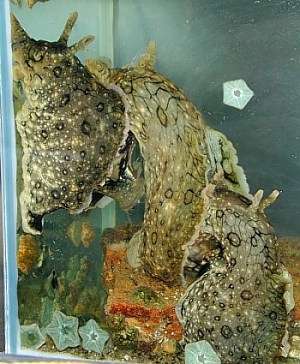
Mating chains
PHOTO
Aplysia dactylomela mating chain. PHOTO: Alison Miller.
Sea Hares, like all sea slugs, are hermaphrodite animals with fully functional male and female reproductive organs. Sometimes, usually in dense populations or in crowded aquariums, they form mating chains of three or more animals, the one at the front acting solely as a female and the one at the rear solely as a male. The animal(s) in between are acting as both males and females.
See messages below.
See also Michael Mrutzek's message [#8036] of a mating chain of the cephalaspidean Chelidonura livida, and Wannapa Thammasangwan's photo [#16512] of C. punctata.
Rudman, W.B., 2000 (May 8) Mating chains. [In] Sea Slug Forum. Australian Museum, Sydney. Available from http://www.seaslugforum.net/find/seahmat
Related messages
The Aplysia language of love
February 16, 2007
From: Scott Cummins
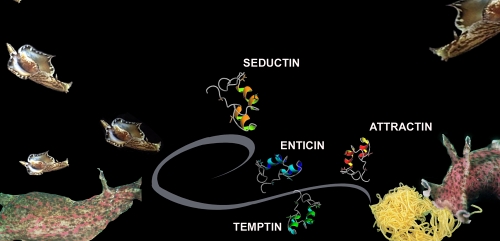
Hi Bill,
I'm interested in sea slug communication and am particularly interested in the mating aggregations that are posted in the Forum. I've been part of the research group in Galveston, Texas, studying chemical communication between Aplysia species. We've found that Aplysia use chemicals (pheromones) to talk with each other. Aplysia has been a particularly good study choice for us because of its well studied reproductive cycle and we knew that egg masses themselves could attract other Aplysia to create the breeding aggregations. Essentially they are trying to tell other Aplysia in the area that they need more sperm, and because they are hermaphrodites they can donate sperm too. As molecular biologists, we can easily manipulate them into laying eggs and collect any pheromones that may also be released. Just to extend on your review of the single pheromone discoveries [message #17419 ]:
We now know that at least two Aplysia species, Aplysia californica and Aplysia brasiliana, release multiple pheromones (they are all small novel proteins) to attract potential mates and stimulate other reproductive behaviours (see refs). So, when an animal lays an egg mass they are also releasing at least 4 pheromone messages into the surrounding seawater, which we've called attractin, enticin, temptin and seductin (see cartoon figure; unpublished) after extensive behavioural analysis. To our knowledge, this is the first invertebrate water-borne cocktail pheromone system to be identified. The reason they need more than one pheromone .....well, we're not sure yet, but probably it gives the detecting animal more information (like we use more than one word to give greater detail), and may provide some kind of species specificity.
So the Aplysia aggregations and mating chains that we see may be caused by this special language that probably only other Aplysia species can sense. The pheromones that are released into the surrounding seawater don't appear to be very species specific, which results in attraction of different species (even A. brasiliana swim to A. californica pheromones). As you've said, there's probably a chemical they recognize upon contact which tells them to get off if they are different species but we haven't discovered this yet. It will be interesting to see if other sea slugs communicate in a similar way.
I plan to further decode this molluscan communication language at University of Queensland in Brisbane, Australia. I'd be interested to hear from anyone who has seen any local Aplysia aggregations in the area and further evidence of multi-species aggregations.
-
Cummins SF, Nichols AE, Amare A, Hummon AB, Sweedler JV, and Nagle GT. (2004) Characterization of Aplysia enticin and temptin, two novel water-borne protein pheromones that act in concert with attractin to stimulate mate attraction. J. Biol. Chem. 279: 25614-25622.
-
Cummins SF, Nichols AE, Warso CJ, Nagle GT. (2005) Aplysia seductin is a water-borne protein pheromone that acts in concert with attractin to stimulate mate attraction. Peptides 26: 351-359.
-
Cummins SF, Nichols AE, Schein CH, Nagle GT. (2006) Newly identified water-borne protein pheromones interact with attractin to stimulate mate attraction in Aplysia. Peptides 27(3): 597-606.
-
Cummins SF, Xie F, Misra M, Amare A, Jakubowski J, de Vries MR, Sweedler JV, Nagle GT, Schein CH. (2007) Recombinant production and structural studies of the Aplysia water-borne protein pheromone enticin indicates it has a novel disulfide stabilized fold. Peptides [Jan 2007].
Thanks.
Scott Cummins.
s.cummins@uq.edu.au
Cummins, S.F., 2007 (Feb 16) The Aplysia language of love. [Message in] Sea Slug Forum. Australian Museum, Sydney. Available from http://www.seaslugforum.net/find/19464Dear Scott,
Firstly welcome to Australia. I have been following your work with interest for some years. I guess we are often only aware of large breeding aggregations when misfortune occurs and they become mass mortality events.
I am sure you will have no problem finding Aplysia populations around Brisbane. What may be interesting is seeing if Bursatella leachii has similar pheromones. One of the first messages to the Forum, nearly 10 years ago, was from the manager of a prawn aquaculture business just south of Brisbane [message #359] who had great numbers of Bursatella in his ponds.
Good luck with your work, please keep us informed of your progress,
Best wishes,
Bill Rudman
Re: Sea Hare 'Love Drug'
August 14, 2006
From: Bill Rudman
Concerning message #9364:
In that earlier message I commented on the discovery of a chemical [pheromone] in the egg masses of Aplysia californica which was named attractin because it appeared to attract Sea Hares and so cause them to aggregate and then mate. Since then the team working on this unique pheromone have found very similar proteins in 5 other species of Aplysia and have studied the effects of A. californica attractin on these species. They have also studied the effect of an artificial hormone made of what they think is the active part of the attractin molecule.
While each species produces a slightly different pheromone, the research shows that Aplysia californica attractin attracts species such as Aplysia brasiliana, whose attractin is chemically very similar. They also describe attractins for Aplysia fasciata, Aplysia depilans and Aplysia vaccaria.
Interestingly the attractins fell into two structural groups, those of A. californica, A. brasiliana and A. fasciata, species which are not found together, all have very similar attractins. On the other hand, A. vaccaria, which is often found in aggregations with A. californica, and A. depilans, often found with A. fasciata, have structurally different attractin molecules. This would suggest that while any Aplysia attractin may interest any species of Aplysia, a particular species needs a species specific, or closely matching attractin molecule, to invoke mating 'closeness'.
Attractins are the first family of waterborne peptide pheromones to have been isolated and characterised in invertebrates.
-
Cummins, S. F., Nichols, A. E., Rajarathnam, K., and Nagle, G. T. (2004) A conserved heptapeptide sequence in the waterborne attractin pheromone stimulates mate attraction in Aplysia. Peptides, 25: 185-189.
-
Painter, S. D., Chong, M. G., Wong, M. A., Gray, A., Cormier, J. G., and Nagle, G. T. (1991) Relative contributions of the egg layer and egg cordon to pheromonal attraction and the induction of mating and egg-laying behaviour in Aplysia. Biological Bulletin, 181: 81-94.
-
Painter, S. D., Cummins, S. F., Nichols, A. E., Akalal, D. G., Schein, C. H., Braun, W., Smith, J. S., Susswein, A. J., Levy, M., de Boer, P. A., ter Maat, A., Miller, M. W., Scanlan, C., Milberg, R. M., Aweedler, J. V., and Nagle, G. T. (2004) Structural and functional analysis of Aplysia attractins, a family of water-borne protein pheromones with interspecific attractiveness. Proceedings of the National Academy of Sciences, 101: 6929-6933.
Best wishes
Bill Rudman
Sea Hare 'Love Drug'
March 8, 2003
From: Bill Rudman
Sam Moore's message reminded me of this paper (Painter, et al, 1998) on the discovery of a chemical produced by Aplysia californica which the authors called attractin and propose is the first waterborne pheromone to be used by invertebrates. The research was headlined in a popular science publication as the 'Slug Love Drug'. Here is a summary of the Abstract:
Although animals in the genus Aplysia are solitary during most of the year, they form breeding aggregations during the reproductive season. The aggregations contain both mating and egg-laying animals and are associated with masses of egg cordons. The egg cordons are a source of pheromones that establish and maintain the aggregation, but none of the pheromones have been chemically characterized. In these studies, specimens of Aplysia were induced to lay eggs, the egg cordons were collected and four active proteins isolated. In T-maze experiments all four proteins increased the number of animals attracted to a nonlaying conspecific. The proteins all contained the same terminal peptide sequence and the full-length peptide (attractin) was isolated from the albumen gland, a large exocrine organ that packages the eggs into a cordon. Attractin is the first water-borne peptide pheromone characterized in molluscs, and the first in invertebrates.
• S. D. Painter, S.D., Clough, B., Garden, R.W., Sweedler, J. V. & Nagle, G.T. (1998) Characterization of Aplysia Attractin, the First Water-borne Peptide Pheromone in Invertebrates. Biological Bulletin, 194: 120-131
Rudman, W.B., 2003 (Mar 8) Sea Hare 'Love Drug'. [Message in] Sea Slug Forum. Australian Museum, Sydney. Available from http://www.seaslugforum.net/find/9364Aplysia dactylomela mating chains
May 27, 2002
From: Anne DuPont
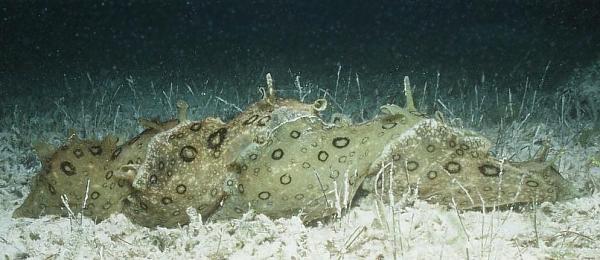
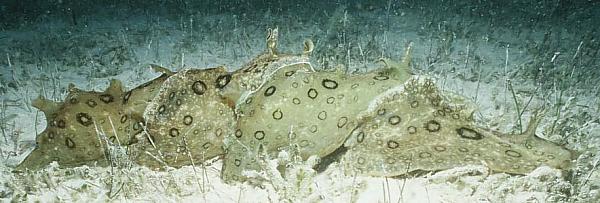
akdupont@bellsouth.net
DuPont, A., 2002 (May 27) Aplysia dactylomela mating chains. [Message in] Sea Slug Forum. Australian Museum, Sydney. Available from http://www.seaslugforum.net/find/7061Dear Bill,
As I mentioned in my separate message, here are some photos of A. dactylomela in mating chains that I took in the southern Bahamas on January 3, 2002. They were together for about 30 minutes in about 4 feet of water. Then slowly one by one they parted, and crawled off their separate ways.
Anne Dupont
Asexual reproduction?
February 2, 2001
From: Wilson
Hi there,
About 4 months ago I purchased a Sea Hare which was later identified to be Aplysia parvula. With what little I know of them other than being hermaphrodites and to a degree algae grazers. Here's the head scratcher...
After having the sea hare for a month, I noticed a tear on the hind quarters and the tear progressed towards the head. It "disappered" and was presumed dead. Last month a small version of it appeared and I thought that the tear healed itself. Today I saw a second one cruising beside it.
The aquarium set up is a 55 gal reef set up in the Jeaubert method. No fish, just mushrooms, button polyps, Dendronepthia sp., Xenia sp., Caulerpa sp., nesseria snails, sand sifting/serpent starfish and sea cucumbers. About 100 lbs of live rock that was originally dead (dry in buckets) but "reanimated" with 10 lbs of live rock. The aquarium has been running for 3 years and the Sea Hare was the latest addition.
I've been smitten by Sea Hares and nudibranchs. Learning what I can and plan on setting up a few more tanks. Great info on this site. I'll be spending many an hour here reading.
Wilson
actinic_03@hotmail.com
Wilson, 2001 (Feb 2) Asexual reproduction?. [Message in] Sea Slug Forum. Australian Museum, Sydney. Available from http://www.seaslugforum.net/find/3674Dear Wilson,
Have a look at the Sea Hares Page for a general introduction to then and an index of other relevant pages.
Concerning asexual reproduction by breaking in two. As far as I know molluscs are a bit far along the evolutionary road to still be able to reproduce that way. What you possibly saw were two Sea hares mating. Have a look at the Sea Hares - mating chains Page and the page on Aplysia cf. parvula for photos showing mating Sea Hares. I have seen pairs of Aplysia cf. parvula mating for some days, and as one partner can be very small, you could have mistaken it for a single animal.
Best wishes,
Bill Rudman
Aplysia mating chain
May 9, 2000
From: Bill Rudman
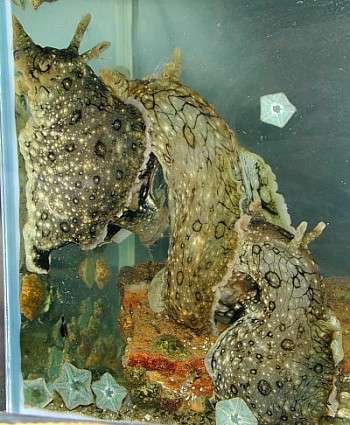
Here is a photo of three Sea Hares [Aplysia dactylomela] mating. By chance we were testing a new digital camera when these animals, which had been collected for public display, decided to ignore the audience and give us something to photograph. PHOTO: Alison Miller.
Sea Hares, like all sea slugs, are hermaphrodite, which means they have a fully functional set of male and female reproductive organs. During mating they can operate as both male and female simultaneously. This is somewhat difficult to achieve when there are only two animals, because the penis is just to the right of the head, and the vagina opens into the mantle cavity between the large parapodia.
Sea Hares, however, commonly occur in quite dense populations and this often leads to a number of animals mating together. The usual method of mating is for the 'male' partner to crawl onto the back of the 'female' partner and the push its head between the parapodial flaps so that its everted penis can enter its partner's vagina. Mating chains occur when a third animal decides to mate with a Sea Hare already acting as a 'male' partner by crawling on its back and inserting its penis. Chains of 4 or 5 animals can at times be found in nature, and in crowded aquaria, even longer chains can form. In these mating chains, the first animal in the chain acts only as a female, and the last acts only as a male, but all the other animals are acting simultaneously as males and females.
Bill Rudman.
Rudman, W.B., 2000 (May 9) Aplysia mating chain. [Message in] Sea Slug Forum. Australian Museum, Sydney. Available from http://www.seaslugforum.net/find/2370Sea Hares - mating chains
June 4, 1998
From: Erwin Koehler
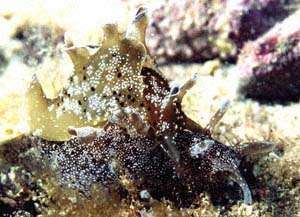
Hello Bill,
I've read (at Steve Long's Opisthobranch Newsletter and at Dr. Peter Wirtz book about Madeira) that Seahares form long chains when mating. I've got 3 photos of Aplysia punctata in the Mediterranean Sea - I thought I got them mating. But in this position it's impossible to build up a chain...
First question: Are they mating?
If not - second question: what else are they doing?
I know, your forum is made for another region and the Med. Sea is far away from Australia...Excuse my GERMENGLISH!
Erwin Koehler
Darmstadt,
Germany
Medslugs.Koehler@t-online.de
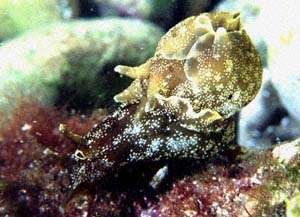
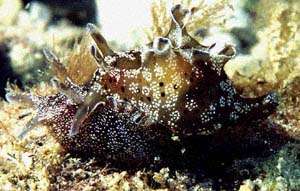
I am happy to receive questions from anywhere. My main concern was getting lots of identification questions from parts of the world where others were more qualified to provide answers. General questions such as yours are relevant to all parts of the world. Your Sea Hares appear to be mating to me. The position different opisthobranchs adopt during mating depends on their
anatomy. Even though they all have male and female organs, the position of the penis and the vagina differs in different groups.
In the true nudibranchs both penis and vagina are close together on the right side of the body. This means two animals must be right side to right side for copulation to take place and each animal is then able to insert its penis into its partner at the same time. With Sea Hares however, the penis is on the right side of the head while the vagina opens in the mantle cavity, beneath the shell, deep down between the parapodia.
In Sea Hares it is therefore physically impossible for mating partners to act as both male and female at the same time. In some species, with relatively short "necks" the only way the "male" partner can insert its penis into the "female's" vagina is to climb onto the female as your animals are doing. Related animals like Notarchus and Bursatella also mate like this.
In some species of Aplysia, such as Aplysia sydneyensis and Aplysia extraordinaria, with relatively long "necks", one animal is able to insert its penis into the vagina of the animal in front while still remaining partially on the substrate. In these species chains of mating animals are quite common.
Mating "chains" occur when animals are clustered closely together, either from being washed together during storms or by being artificially housed in buskets or small aquaria. In these situations even "short-necked" species can form chains. Chain-forming is not exclusive to Sea Hares and aglajiid bubble shells such as Chelidonura and Melanochlamys readily form chains when collected in relatively small containers. I have seen three or four aglajiids in a mating chain in the field, and in aquaria I have seen 10-15 together.
So the answer is yes, Sea Hares do sometimes mate in chains, but they also mate in pairs with one acting as a male, the other as a female. Chain mating is different from the reciprocal mating in nudibranchs because in Sea Hares the animal receiving sperm gives its own sperm to a third slug .... Bill Rudman.
Rudman, W.B., 1998 (Jun 4). Comment on Sea Hares - mating chains by Erwin Koehler. [Message in] Sea Slug Forum. Australian Museum, Sydney. Available from http://www.seaslugforum.net/find/140